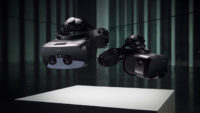Varjo Debuts High Resolution XR/VR Headsets for Enterprise
December 4, 2020
Finland-based Varjo debuted its third generation XR/VR headsets, the XR-3 and VR-3, respectively, which still target enterprises rather than consumers. The company’s chief marketing officer Jussi Mäkinen stated that this version doubles its so-called human-eye resolution from the previous model and cuts the price in half. The Varjo XR-3 is priced at $5,495, with the Varjo subscription starting at $1,495 for the year. The Varjo VR-3 costs $3,195 with a one-year subscription starting at $795.
VentureBeat reports Mäkinen noted that, although the prices are high, “at a time when many design teams can’t work together in person anymore, [they] can offer a good return on investment, replacing processes that take a lot of time and are a lot more expensive.”

Varjo chief innovation officer Urho Konttori said the company has “made a lot of progress over the years in terms of balancing the cost, technology, and variety of applications,” adding that both displays offer ultra-high resolution, run at 90Hz and have 99 percent RGB color accuracy, all important for use cases that require photorealism.
According to Mäkinen, the biggest markets are training, simulation, design, and engineering and, more recently medical imaging and research.
Varjo defines the “human-eye resolution” of its full-frame bionic display as featuring 1,920 pixels x 1,920 pixels per eye for the central area and 2,880 x 2,720 for the periphery. The field of view is 115 degrees. That’s an improvement over its first headset, debuted in early 2019, with “a resolution of 1,920 x 1,080 per eye and an 87-degree field of view.”
The XR-3 now offers inside-out tracking, via “cameras on the headset itself that sense the environment” rather than any external sensors. They also offer “accurate eye-tracking at up to 200Hz, giving users optimized visual fidelity through foveated rendering (which makes a display run faster by blurring your peripheral vision in areas where you aren’t actively looking).”
Both the XR-3 and VR-3 feature “integrated Ultraleap hand tracking (licensed from the Leap Motion creators) for natural interactions that involve tracking your finger movements” and offer “a three-point precision fit headband, 40 percent lighter weight, active cooling, and ultra-wide optical design for removing eye strain and simulator sickness.”
The headset weighs 1.3 pounds, without optional counterweight. Software “is compatible with applications built in Unity, Unreal Engine, OpenXR 1.0 (in early 2021) and hundreds of industrial 3D engines and applications, including Autodesk VRED, Lockheed Martin Prepar3d, VBS BlueIG, and FlightSafety Vital.” The XR-3, which can be used for augmented reality, “has depth awareness with Lidar sensors and stereo RGB video pass-through so you can see the outside world accurately with the flip of a switch.”
Both next-gen headsets can be ordered now on the company’s website and through its resellers, for shipment in early 2021.

No Comments Yet
You can be the first to comment!
Sorry, comments for this entry are closed at this time.